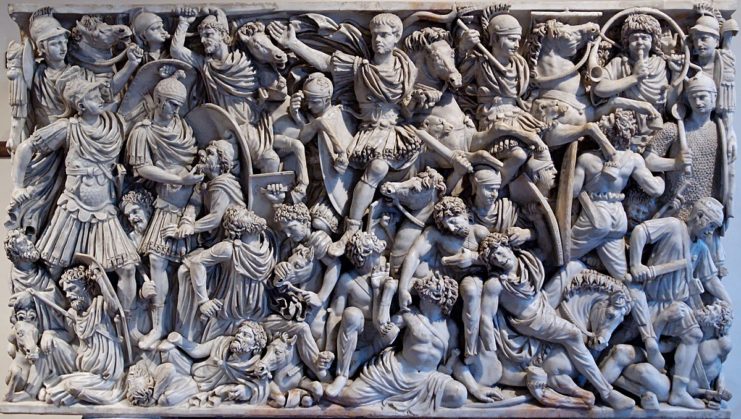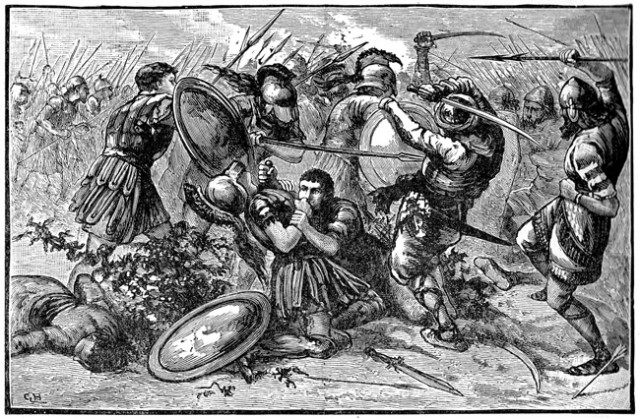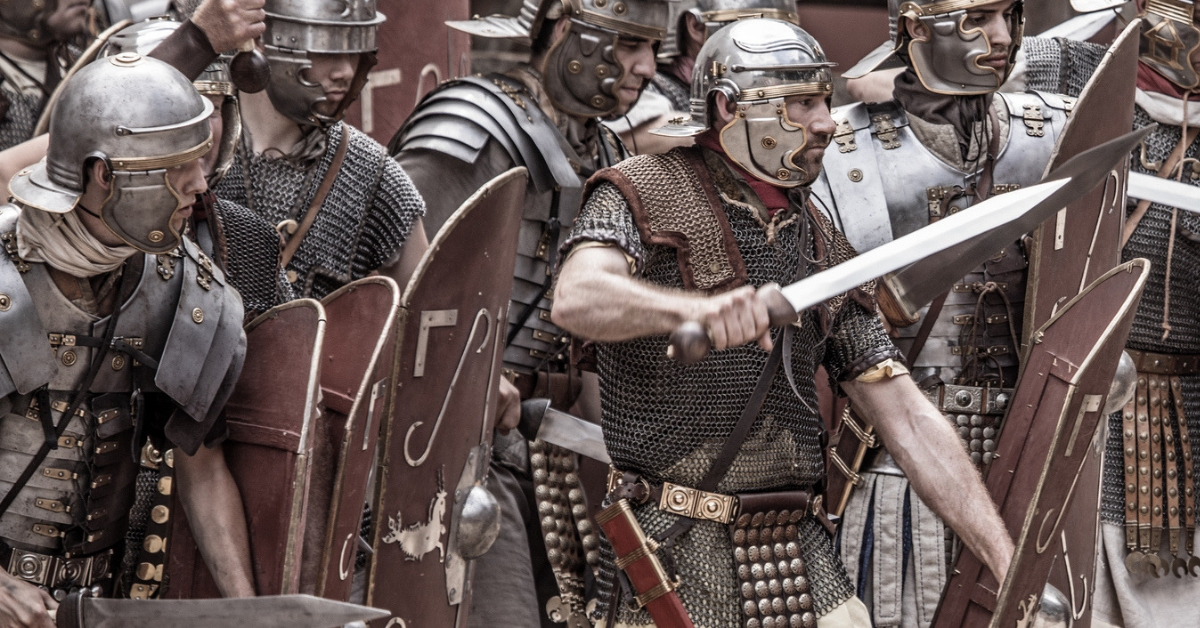What was it actually like to fight with the heavy infantry on an ancient battlefield? The average person has their views shaped by Hollywood, but even the historians have perspectives shaped by thrilling but often unrealistic tales from the ancient sources.
Herodotus, Livy, Plutarch and many others give a good account of battles for a general understanding, but the most difficult task is getting a good sense of how battles worked on an individual scale. Note: any interpretation of the individual’s experience in battle is highly speculative, and there are multiple schools of thought on the topic, the following is but one of them.
In the recently reviewed Troy, there is a fantastic battle scene where the Greeks charge wildly at the Trojans in front of their walls. The camera travels across the front lines showing men jumping over others and spears flying. Many ancient sources would present battle in a similar manner, brave, heroic and bloody.
The problem is that one of the most basic motivations of all humans is simply to stay alive. Leaping over an enemies shield to land awkwardly and surrounded by enemies is going so directly against that most primal human trait that it is unreasonable to expect any significant portion of combatants to have done that. Of course, adrenaline flows heavy in battle, so acts of bravery that suspend the drive to stay alive certainly happened, but preserving one’s life usually shaped the actions during a battle.
As a frontline soldier, the burden of charging was on you. Romans had it a bit easier as back to back volleys of Pila usually softened the enemy and charges usually hit the opponents, sending their front lines backwards.
The charge was mainly an attempting and routing an enemy before the grind of battle began; the buildup of nerves, intimidation from war cries, fancy armor or sheer overwhelming numbers could cause a group of men to snap and flee before the charge ever hit. This is seen at the battle of Cunaxa where the Greek mercenaries had such a reputation that none of the Persians would close with them.

If a charge didn’t prevail then what likely happened next was a break of action. The two sides would stand maybe 5-10 feet apart, and sporadic lunges into the newly formed no man’s land would occur. This could happen after a charge if no side gained an immediate advantage or charges may have even stopped short before forming the battle lines.
This no man’s land is so against most conceptions as it lacks the constant action most people associate with ancient battles. The reality was that after a charge, the men became scared for their safety and made sure that they had allies around them, the easiest way to get killed was to be hit from a direction you were not aware of.
As lines were established, the time for your true bravery came. Soldiers would lunge out in groups to attack the enemy, as few as one man or whole unite such as a Roman maniple. This is where such small unit officers like the centurions were so important, leading from the front they exhorted their men to be brave and attack and often led by example and started the attacks.
These attacks were often quick with attempted strikes and a quick retreat into the line for your own safety. If an enemy was struck down every effort was made to take advantage of that gap, however, occupying that gap meant you were surrounded on three sides by the enemy, so a quick retreat or a quick death were often next.
In terms of the frontlines, battles were often won when gaps were finally exploited and opened. Formations and line cohesion were vital in ancient battles, even when those “formations” were little more than mobs facing the same direction.
If an enemy was killed and your group took his spot and persevered, killing more enemies, then the no man’s land would turn into a funnel as the success and prospect of victory would spur the men forward into the breach. Like a wedge, this opening would start dividing the enemy.

Once a gap opened up the enemy began to panic. Crowd dynamics starts to play a major role as people in groups are far more irrational than normal. As the enemy begin to flee those around them start to notice. To step into the enemy’s shoes: even if your immediate area of battle is going well, the sight of your comrades fleeing would be majorly unsettling.
Asking why only escalates the fear and uncertainty and soon the overwhelming desire to preserve your life from this unknown occurrence forces you to join them. The ancient soldier was well aware that most of a battles casualties occur from chasing down fleeing enemies. Rather than thinking they might prevail if the stay and fight, most men are thinking that the longer they stay as their comrades are abandoning them, the less of a head start they will have. Every second standing you ground may bring you one step closer to being cut down by the enemy’s cavalry and finally you run to save your life.
Back to the victorious army; the enemy is breaking, you have survived the most dangerous phase, enemy missile fire has all but ceased as the enemy skirmishers have begun to rout as well. The glory of victory consumes you, and now the battle becomes a contest to see how much loot, in the form of armor or jewelry that you could secure from those dead or still fleeing.
If the enemy camp is in sight then you best hurry to raid it, as the treasury for the campaign, soldiers wages and countless other treasures are simply waiting to be claimed.
Ancient battles generally had a very low death rate for the victors and large rate for the losers. Wounded victors could simply sit and wait for military doctors to tend to them while wounded losers would lag behind and be cut down or captured. This was a very brief overview of a standard stereotypical battle, say a Roman battle during one of their many civil wars.
Many battles were unique in their own way however and something changed the typical order of battle, for example, Caesar’s victory at Pharsalus was fairly standard on the front lines. However the veteran legionaries of Caesar were smart enough to take a break in the middle of their long charge to rest, and the last line of infantry who countered Pompey’s cavalry were key.
In the frontlines of the infantry battle, the veterans held a distinct advantage, keeping their calm and knowing just how to exploit the enemy.
